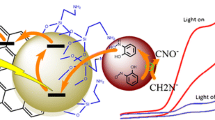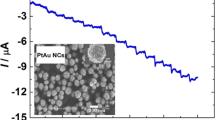Abstract
An amperometric method for hydrazine detection is described that is based on the use of electrochemically reduced graphene oxide (ERGO) that was modified with Pt-Pd nanoparticles. A glassy carbon electrode (GCE) was first modified with GO nanosheets and then electrochemically reduced, by applying a negative potential of −1.1 V, to form a film of ERGO. The ERGO-modified GCE was further modified by immersing it into a solution containing Pt(II) and Pd(II) ions solution and reduction via cyclic voltammetry to form the respective nanoparticles. The morphology and structure of the nanohybrid were characterized using field emission scanning electron microscopy (FESEM), atomic force microscopy and X-ray energy dispersive spectroscopy. FESEM images revealed the Pt-Pd nanoparticles on ERGO to have dimensions of <100 nm. Cyclic voltammetry of this GCE showed the oxidation current for hydrazine in 0.1 M NaOH solution to be higher than that for a Pt-Pd/GCE or an ERGO/GCE. In parallel, the overpotential for hydrazine oxidation is reduced. The amperometric nanosensor, best operated at a working potential of −0.71 V (vs. Ag|AgCl|KCl), has a linear response in the 0.007–5.5 mM hydrazine concentration range and a 1.7 μM detection limit. It has good selectivity over other species.

Pt-Pd nanoparticles were placed on electrochemically reduced graphene oxide nanosheets and then used to modify a glassy carbon electrode. A sensor was obtained that can quantify hydrazine in 0.1 M NaOH solution with a 1.7 μM detection limit.








Similar content being viewed by others
References
Garrod S, Bollard ME, Nicholls AW, Connor SC, Connelly J, Nicholson JK, Holmes E (2005) Integrated metabonomic analysis of the multiorgan effects of hydrazine toxicity in the rat. Chem Res Toxicol 18:115–122
Wang S, Ma S, Zhang J, She M, Liu P, Zhang S, Li J (2018) A highly sensitive and selective near-infrared fluorescent probe for imaging hydrazine in living tissues and mice. Sensors Actuators B Chem 261:418–424
Moreno CM, Stadler T, da Silva AA, Barbosa LC, de Queiroz MEL (2012) Determination of maleic hydrazide residues in garlic bulbs by HPLC. Talanta 89:369–376
Ortega-Barrales P, Molina-Díaz A, Pascual-Reguera M, Capitán-Vallvey L (1997) Solid-phase spectrophotometric determination of trace amounts of hydrazine at sub-ng mL− 1 level. Anal Chim Acta 353:115–122
Singh N, Mohan S (1996) A new potentiometric determination of hydrazine in the presence of uranium (IV). J Radioanal Nucl Chem 209:211–215
Amiripour F, Azizi SN, Ghasemi S (2018) Gold-copper bimetallic nanoparticles supported on nano P zeolite modified carbon paste electrode as an efficient electrocatalyst and sensitive sensor for determination of hydrazine. Biosens Bioelectron 107:111–117
Huang H, Li T, SunLinghui Y, Changding Y, Rong W, Weichun S, Ye DW, Li Y (2019) Amperometric sensing of hydrazine in environmental and biological samples by using CeO2-encapsulated gold nanoparticles on reduced graphene oxide. Microchim Acta 46:186
Sivakumar M, Veeramani V, Chen S, Madhu R, Liu S (2019) Porous carbon-NiO nanocomposites for amperometric detection of hydrazine and hydrogen peroxide. Microacim Acta 186:59
Ghasemi S, Hosseini SR, Nabipor S (2018) Preparation of nanohybrid electrocatalyst based on reduced graphene oxide sheets decorated with Pt nanoparticles for hydrogen evolution reaction. J Iran Chem Soc 16:101–109
Bai Z, Dong W, Ren Y, Zhang C, Chen Q (2018) Preparation of Nano Au and Pt alloy microspheres decorated with reduced graphene oxide for nonenzymatic hydrogen peroxide sensing. Langmuir 34:2235–2244
Wang D, Li Y (2011) Bimetallic nanocrystals: bimetallic nanocrystals: liquid-phase synthesis and catalytic applications. Adv Mater 23:1036–1036
Chen A, Holt-Hindle P (2010) Platinum-based nanostructured materials: synthesis, properties, and applications. Chem Rev 110:3767–3804
Wang J, Pamidi PVA, Cepria G (1996) Electrocatalysis and amperometric detection of aliphatic aldehydes at platinum-palladium alloy coated glassy carbon electrode. Anal Chimi Acta 330:151–158
Hossain Jae MF, Park Y (2014) Amperometric glucose biosensor based on Pt-Pd nanoparticles supported by reduced graphene oxide and integrated with glucose oxidase. Electroanalysis 26:940–951
He B, Yan S (2019) Voltammetric kanamycin aptasensor based on the use of thionine incorporated into Au@Pt core-shell nanoparticles. Microchim Acta 186:77
Li J, Rong H, Tong X, Wang P, Chen T, Wang Z (2018) Platinum–silver alloyed octahedral nanocrystals as electrocatalyst for methanol oxidation reaction. J Colloid Interface Sci 513:251–257
Sha R, Vishnu N, Badhulika S (2018) Bimetallic Pt-Pd nanostructures supported on MoS2 as an ultra-high performance electrocatalyst for methanol oxidation and nonenzymatic determination of hydrogen peroxide. Microchim Acta 185:399
Kim JD, Choi MY, Choi HC (2017) Graphene-oxide-supported Pt nanoparticles with high activity and stability for hydrazine electro-oxidation in a strong acidic solution. Appl Surf Sci 420:700–706
Krittayavathananon A, Srimuk P, Luanwuthi S, Sawangphruk M (2014) Palladium nanoparticles decorated on reduced graphene oxide rotating disk electrodes toward ultrasensitive hydrazine detection: effects of particle size and hydrodynamic diffusion. Anal Chem 86:12272–12278
Esabattina S, Posa VR, Zhanglian H, Godlaveeti SK, Reddy RRN, Somala AR (2018) Fabrication of bimetallic PtPd alloy nanospheres supported on rGO sheets for superior methanol electro-oxidation. Int J Hydrog Energy 43:4115–4124
Chen X, Tian X, Zhao L, Huang Z, Oyama M (2014) Nonenzymatic sensing of glucose at neutral pH values using a glassy carbon electrode modified with graphene nanosheets and Pt-Pd bimetallic nanocubes. Microchim Acta 181:783–789
Fu G, Wu K, Lin J, Tang Y, Chen Y, Zhou Y, Lu T (2013) One-pot water-based synthesis of Pt–Pd alloy nanoflowers and their superior electrocatalytic activity for the oxygen reduction reaction and remarkable methanol-tolerant ability in acid media. J Phys Chem C 117:9826–9834
Sun Y, Mayers BT, Xia Y (2002) Template-engaged replacement reaction: a one-step approach to the large-scale synthesis of metal nanostructures with hollow interiors. Nano Lett 2:481–485
Döner A, Tezcan F, Kardaş G (2013) Electrocatalytic behavior of the Pd-modified electrocatalyst for hydrogen evolution. Int J Hydrog Energy 38:3881–3888
Hummers WS, Offeman RE (1958) Preparation of graphitic oxide. J Am Chem Soc 80:1339–1339
Ghasemi S, Reza Hosseini S, Mousavi F (2017) Electrophoretic deposition of graphene nanosheets: a suitable method for fabrication of silver-graphene counter electrode for dye-sensitized solar cell. Colloid Surf A Physicochem Eng Asp 520:477–487
Ghasemi S, RezaHosseini S, Nabipour S, Asen P (2015) Palladium nanoparticles supported on graphene as an efficient electrocatalyst for hydrogen evolution reaction. Int J Hydrog Energy 40:16184–16191
Shimazu K, Weisshaar D, Kuwana T (1987) Electrochemical dispersion of Pt microparticles on glassy carbon electrodes. J Electroanal Chem Interfacial Electrochem 223:223–234
Tamašauskaitė-Tamašiūnaitė L, Rakauskas J, Balčiūnaitė A, Zabielaitė A, Vaičiūnienė J, Selskis A, Juškėnas R, Pakštas V, Norkus E (2014) Gold–nickel/titania nanotubes as electrocatalysts for hydrazine oxidation. J Power Sources 272:362–370
Heydari H, Gholivand MB, Abdolmaleki A (2016) Cyclic voltammetry deposition of copper nanostructure on MWCNTs modified pencil graphite electrode: an ultra-sensitive hydrazine sensor. Mater Sci Eng C 66:16–24
Gioia D, Casella IG (2016) Pulsed electrodeposition of palladium nano-particles on coated multi-walled carbon nanotubes/nafion composite substrates: Electrocatalytic oxidation of hydrazine and propranolol in acid conditions. Sensors Actuators B Chem 237:400–407
Wu J, Zhou T, Wang Q, Umar A (2016) Morphology and chemical composition dependent synthesis and electrochemical properties of MnO2-based nanostructures for efficient hydrazine detection. Sensors Actuators B Chem 224:878–884
Lee KK, Loh PY, Sow CH, Chin WS (2013) CoOOH nanosheet electrodes: simple fabrication for sensitive electrochemical sensing of hydrogen peroxide and hydrazine. Biosens Bioelectron 39:255–260
Rao D, Sheng Q, Zheng J (2016) Preparation of flower-like Pt nanoparticles decorated chitosan-grafted graphene oxide and its electrocatalysis of hydrazine. Sensors Actuators B Chem 236:192–200
Yue X, Yang W, Xu M, Liu X, Jia J (2015) High performance of electrocatalytic oxidation and determination of hydrazine based on Pt nanoparticles/TiO2 nanosheets. Talanta 144:1296–1300
Acknowledgements
This work was supported by University of Mazandaran, research council.
Author information
Authors and Affiliations
Corresponding author
Ethics declarations
The author(s) declare that they have no competing interests.
Additional information
Publisher’s note
Springer Nature remains neutral with regard to jurisdictional claims in published maps and institutional affiliations.
Electronic supplementary material
ESM 1
(DOCX 1506 kb)
Rights and permissions
About this article
Cite this article
Ghasemi, S., Hosseini, S.R., Hasanpoor, F. et al. Amperometric hydrazine sensor based on the use of Pt-Pd nanoparticles placed on reduced graphene oxide nanosheets. Microchim Acta 186, 601 (2019). https://doi.org/10.1007/s00604-019-3704-2
Received:
Accepted:
Published:
DOI: https://doi.org/10.1007/s00604-019-3704-2




